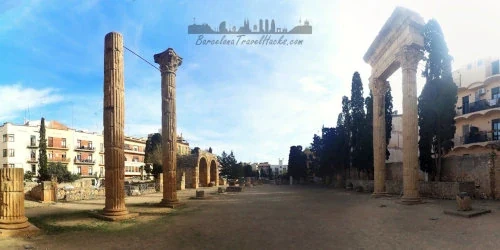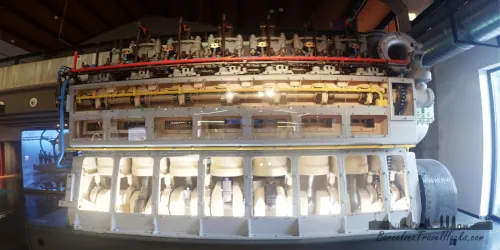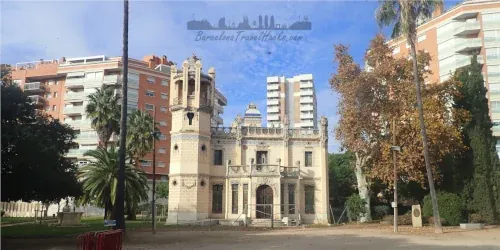Please sign in with Google to view the map.
Sign in with GoogleEarly Christian cemetery | Tàrraco Necròpolis paleocristiana
Archaeological excavations (1923 - 1933) reaveal large Roman Christian burial site. Excavations were triggered by works to expand the adjacent tobaco factory
About Early Christian cemetery of Tarraco (MNAT)
Archaeological excavations between 1923 and 1933 revealed the site of a major paleo-Christian cemetery. This necropolis was used from the Roman era up until the 7th century. Both pagan and Christian burial sites have been found, containing sarcophagi, amphora, tombs, etc. Most of these findings can be seen in the Tarragona Archaeological Museum.
In the early 3rd century AD, departing Tàrraco towards the south on the Via Augusta was a densely populated suburb that stretched between the walled town, the port and the river Tulcis (today called the river Francolí). This area outside of the city walls was occupied by warehouses and other port facilities as well as some suburban houses and craft workshops.
On either side of the Via Augusta and the other main roads there was a large number of tombs. Sometimes the remains of the deceased were indicated with just a small tumulus, while others had grand mausoleums and funerary monuments built by their families to demonstrate their magnificence.
Roman Burial Traditions
In ancient Roman religion, the Manes are chthonic (inhabiting the underworld) deities sometimes thought to represent souls of deceased loved ones. They were associated with the Lares, Lemures, Genii, and Di Penates as deities (di) that pertained to domestic, local, and personal cult. They belonged broadly to the category of di inferi, "those who dwell below," the undifferentiated collective of divine dead. The Manes were honored during the Parentalia (nine-day festival of rites and rituals celebrating deceased family ancestors) and Feralia (ancient Roman public festival celebrating the Manes) in February.
The Romans believed that the dead had to receive the necessary funerary rites so that that the Manes (ancestor spirits) would receive him or her among them. If not the soul would be condemned to wander eternally in the form of an evil spirit. Thus, after the preparatory ceremonies, the body was taken in procession to the place of rest, outside the walls and alongside a road or path.
Once the body had been buried, a funerary banquet was held next to the tomb. The tombs covered by a kind of table (mensa) that we find in the Early Christian Necropolis of Tarragona correspond to this ritual.
May the earth rest lightly on you is a poetic expression that appears on many Roman epitaphs. It expressed the desire that the weight of the earth covering the body should not prevent the deceased's soul from beginning its journey to the afterlife.
Early Christian Burial Traditions
The Christians maintained similar funerary practices and customs to the Romans, although over time they began to take on different meanings. By the late 2nd century AD, Burial became the the most common practice rather than cremation. The place and type of burial mainly depended on the social and economic status of the deceased. They ranged from a simple grave dug in the earth to a sumptuous mausoleum with a funerary crypt.
On Friday 21 January 259, on the orders of the provincial governor, the christian bishop of Tarraco Fructuosus, and his deacons Augurius and Eulogius, were burned alive in the arena of the amphitheatre.
Their remains were collected and taken to the main cemetery on the banks of the River Francolí. Their presence would have made it a desirable place for the members of Tàrraco's Christian community to be laid to rest near the tombs of the saints (tumulatio ad sanctos).
At the beginning of the 5th century, with Christianity now the official religion of the Roman Empire, a basilica dedicated to the memory of the saints was built in the area of their tombs. To the north, in this same period, another basilica was built as part of an important ecclesiastical complex that was in use until the 7th century.
The fish, the dove, the cross, the palm, the chrismon and the ring are all Christian symbols that have been found on various tombs in the Early Christian Necròpolis of Tarragona.
Notable Tombs discovered at Tàrraco Necròpolis
Two crypts were found during the excavations of the necropolis, the Crypt of the Arches and the Crypt of the Engineers. Simple graves could contain coffins made of diverse materials, including wood, stone, lead, tiles or cut-down amphoras (Short pithy text carved into stone). Above ground, a more or less elaborate tumulus (mound) indicated the position of the tomb, sometimes in mainly family groupings.
Burials inside mausoleums and churches were in decorated sarcophaguses or below tombstones made of high-quality marble or with mosaic decoration. Various sculptures that would have formed part of different funerary monuments have also been found. Death was also taken advantage of to demonstrate the status and power of the living. Normally the deceased were buried just with the cloth that acted as their shroud.
In exceptional cases objects relating to the life of the deceased can be found. An example is the burial of a girl of about five who was buried with an ivory doll, an extraordinary piece that was to be her plaything for the rest of eternity. Her epitath reads The innocent Marturia lived for four years. She left in the year of the first consulate of Eugenius Augustus. Marturia, may you live among the blessed. The burial dates from 393 AD and is a Christian burial. The cause of her death cannot be determined as an incurable illness or an accident.
From Headstone inscriptions, we know that the citizens of Tàrraco had names such as Lucius, Marturia, Optimus, Ampelius and Fabian and that they were soldiers, jewellers, politicians and architects. We know that some of them had very short lives, while others lived nearly ninety years. We know that some were pagans and that others were Christians. We know that there were people born in Tàrraco and others who came from inland Hispania or such distant places as Greece and Egypt.
Studies of the bones reveal that the average height of the inhabitants of Tarraco was 1.65 m for men and 1.54 m for women.
Tàrraco Early Christian cemetery Necròpolis History
- 1923: Construction work for the new tobacco factory revealed a large number of archaeological remains of an extensive cemetery (more than 2,000 documented burials) dating from the 3rd to 5th century AD on the banks of the River Francolí.
- 1924: The archaeological excavations were supervised by Monsignor Joan Serra i Vilaró, an archaeologist from the catholic church. It is thanks to his thorough documental and scientific work that the cemetery is preserved.
- 1930: Comissioned by Joan Serra i Vilaróins, the building in the centre of thre site was build to serve as a dry wharehouse and cover for the cemetery as well as labratory and study space. Later it was converted into a museum space, El museo monográfico.
- 1992: The Necròpolis central museum building closes to the public due to deterioration of the structure.
Image Gallery For Early Christian cemetery of Tarraco (MNAT)
Click on any of the 47 images to open full screen gallery player. Note that viewing images is subject to our Fair Use Policy.
Visiting Early Christian cemetery of Tarraco (MNAT)
The remains open to the public include a residential sector (a suburban domus and a productive area) and part of the extensive graveyard of this necropolis. This is supplemented by an interpretation centre which focuses on Roman attitudes to death.
Today, 100 years later, you can still see part of the Necròpolis and some of its most outstanding pieces, such as the Tombstone of Optimus and the Sarcophagus of the Lions. An interpretation centre offers visitors information on the world of the dead in Tarraco during the Roman and Late Roman periods during the christian conversion.
Note that the entrance is not via the building that can be acessed via the skybridge. Continue walking a further 150 metres down Avenida de Ramón y Cajal to find the entrance via a ramp.
Allow 30 to 60 minutes to visit the Necròpolis.
The Tàrraco Necròpolis museum is run by the Museu Nacional Arqueològic de Tarragona (MNAT) and the entry ticket includes access to the MNAT museum in Tarragona Port.
Tàrraco Early Christian cemetery Necròpolis opening hours
- January, February, November & December:
- Tuesday to Saturday: 09:30h to 13:30h & 15:00h to 17:30h
- Sunday and Holiday's: 10:00h to 14:00h
- March, April, May & October:
- Tuesday to Saturday: 09:30h to 13:30h & 15:00h to 18:00h
- Sunday and Holiday's: 10:00h to 14:00h
- June, July, August & September:
- Tuesday to Saturday: 10:00h to 13:30h & 16:00h to 20:00h
- Sunday and Holiday's: 10:00h to 14:00h
- Closed: Monday's, 25th & 26th December, 1st January, 1st May.
- Free Entry:19th August (Sant Magí), 23rd September (Santa Tecla) 10:00h to 14:00h
What to take with you for Early Christian cemetery of Tarraco (MNAT)
For the Tarragona day trip I pack a small 10L rucksack with a fleece jersey and if the weather forecast says rain, a waterproof poncho. Wear comfortable shoes so that your ankles are not destroyed on the cobble streets.
NOTE: The information plaques are in Spanish so take headphones and download the museum audioguide app.
Early Christian cemetery of Tarraco (MNAT) Summary of Prices
Getting to Early Christian cemetery of Tarraco (MNAT)
Address: Avenida de Ramón y Cajal 84, Tarragona, 43005
Map forEarly Christian cemetery of Tarraco (MNAT)
Weather for Early Christian cemetery of Tarraco (MNAT)
Where to stay overnight near Early Christian cemetery of Tarraco (MNAT
Nearby Attractions to Early Christian cemetery of Tarraco (MNAT)
 TRAIN
TRAIN
Tarragona Roman Colonial Forum | Fòrum colonial de Tarraco
30BC Colonial Forum meeting & adminastrative centre for Roman city of Tàrraco. Temple dedicated to the gods of Jupiter, Juno & Minerva
Read more >
 TRAIN
TRAIN
Tarragona Port Museum | Museu del Port de Tarragona
Free museum run by Tarragona Port Authority. Artifacts from port activities & community of dock workers. History of the port from Roman times to current day
Read more >
 TRAIN
TRAIN